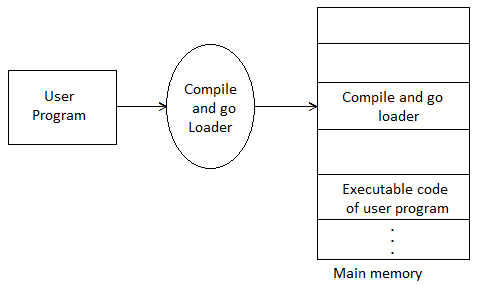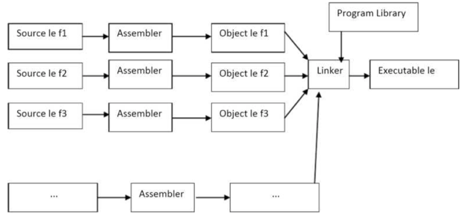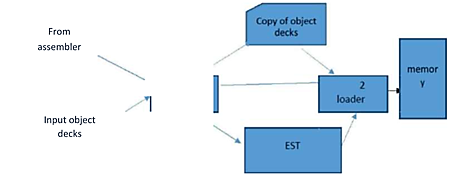Unit - 4
Linker and Loader
Q1) Introduce loader?
A1) The loader is a program which takes this object program, prepares it for execution, and loads this executable code of the source into memory for execution.
Definition
Loader is utility program which takes object code as input prepares it for execution and loads the executable code in to the memory. Thus loader is actually responsible for initiating the execution process.
Functions of loader
The loader is responsible for the activities such as allocation, linking, relocation and loading
1) It allocates the space for the program in the memory, by calculating the size of the program. This activity is called allocation.
2) It resolves the symbolic references (code/data) between the object modules by assigning all the user subroutine and library subroutine addresses. This activity is called linking.
3) There are some address dependent locations in the program, such address constants must be adjusted according to allocated space, such activity done by loader is called relocation.
4) Finally it places all the machine instructions and data of corresponding programs and subroutines into the memory. Thus the program now becomes ready for execution.
Q2) What is linker?
A2) Linker
A linker is a programme that combines object files generated by the compiler/assembler with other bits of code to create an executable file. Exe is an executable file. The linker searches and appends any libraries required for the file's execution in the object file. It controls the amount of memory allocated to each module's code. It also combines two or more different object programmes into one and creates a link between them.
There are two sorts of linkers in general:
1. Linkage Editor: It's a linker that creates an executable, relocatable module.
2. Dynamic Linker: The linkage of some external modules is deferred/postponed until the load module/executable module is generated by the Dynamic Linker. Linking is done during the load or run time in this case.
Q3) Write the difference between linker and loader?
A3) Difference between linker and loader
S. No. | LINKER | LOADER |
1 | The main function of Linker is to generate executable files. | Whereas main objective of Loader is to load executable files to main memory. |
2 | The linker takes input of object code generated by compiler/assembler. | And the loader takes input of executable files generated by linker. |
3 | Linking can be defined as process of combining various pieces of codes and source code to obtain executable code. | Loading can be defined as process of loading executable codes to main memory for further execution. |
4 | Linkers are of 2 types: Linkage Editor and Dynamic Linker. | Loaders are of 4 types: Absolute, Relocating, Direct Linking, Bootstrap. |
5 | Another use of linker is to combine all object modules. | It helps in allocating the address to executable codes/files. |
6 | Linker is also responsible for arranging objects in program’s address space. | Loader is also responsible for adjusting references which are used within the program. |
Q4) What is the task of the loader?
A4) A loader's tasks include the following:
● Check the software for memory needs, permissions, and other issues.
● Copy necessary files from the disc into memory, such as the programme image or required libraries.
● Add the necessary command-line parameters to the stack.
● Link the program's start point as well as any other libraries that are required.
● Set up the registers.
● Return to the memory location where the programme began.
Q5) Define compile and go loader?
A5) In this type of loader, the instruction is read line by line, its machine code is obtained and it is directly put in the main memory at some known address. That means the assembler runs in one part of memory and the assembled machine instructions and the data is directly put into their assigned memory locations. After completion of the assembly process, assign the starting address of the program to the location counter.
The typical example is WATFOR-77, it’s a FORTRAN compiler which uses such “load and go” scheme.
“Assembler-and-go” is another name for compile and go loader. To comprehend the various loader schemes, the concept "segment" must be introduced. A segment is a single source or object deck that corresponds to a single unit of information, such as a program or data. The compile and go loader is depicted in a diagram.
The compile and go loader runs the assembler program in one section of memory and then loads the completed machine instructions and data into their respective memory regions. Once the assembly is complete, the assembler passes control to the program's starting instruction.

Fig 1: Compile and go
Advantages:
This scheme is simple to implement. Because assembler is placed at one part of the memory and loader simply loads assembled machine instructions into the memory.
Q6) Write the disadvantages of compile and go loader?
A6) Disadvantages:
- In this scheme some portion of memory is occupied by assembler which is simply wastage of memory. As this scheme is combination of assembler and loader activities, this combination program occupies large block of memory.
- There is no production of .obj file, the source code is directly converted to executable form. Hence even though there is no modification in the source program it needs to be assembled and executed each time, which then becomes a time consuming activity.
- It cannot handle multiple source programs or multiple programs written in different languages. This is because assembler can translate one source language to other target language.
- For a programmer it is very difficult to make an orderly modulator program and also it becomes difficult to maintain such program, and the “compile and go” loader cannot handle such programs.
- The execution time will be more in this scheme as every time program is assembled and then executed.
Q7) What do you mean by general loader scheme?
A7) In this loader scheme, the source program is converted to object program by some translator (assembler). The loader accepts these object modules and puts machine instruction and data in an executable form at their assigned memory. The loader occupies some portion of main memory.
Advantages:
● The program need not be retranslated each time while running it. This is because initially when source program gets executed an object program gets generated. Of program is not modified, then loader can make use of this object program to convert it to executable form.
● There is no wastage of memory, because assembler is not placed in the memory, instead of it, loader occupies some portion of the memory. And size of loader is smaller than assembler, so more memory is available to the user.
● It is possible to write source program with multiple programs and multiple languages, because the source programs are first converted to object programs always, and loader accepts these object modules to convert it to executable form.
The following diagram shows the functionalities of general loader.

Fig 2: General loader
Q8) Describe absolute loader?
A8) Absolute loader is a kind of loader in which relocated object files are created, loader accepts these files and places them at specified locations in the memory. This type of loader is called absolute because no relocation information is needed; rather it is
Obtained from the programmer or assembler. The starting address of every module is known to the programmer, this corresponding starting address is stored in the object file, then task of loader becomes very simple and that is to simply place the executable form of the machine instructions at the locations mentioned in the object File.
In this scheme, the programmer or assembler should have knowledge of memory management. The resolution of external references or linking of different subroutines are the issues which need to be handled by the programmer. The programmer should take care of two things: first thing is specification of starting
Address of each module to be used. If some modification is done in some module then the length of that module may vary.
This causes a change in the starting address of immediate next modules, its then the programmer’s duty to make necessary changes in the starting addresses of respective modules. Second thing is, while branching from one segment to another the absolute starting address of respective module is to be known by the programmer so that such address can be specified at respective JMP instructions.
For example
Line number
1 MAIN START 1000
1 JMP 5000
16 STORE instruction at location 2000
END
1 SUM START 5000
2
20 JMP 2000
21 END
In this example there are two segments, which are interdependent. At line number 1 the assembler directive START specifies the physical starting address that can be used during the execution of the first segment MAIN.
Then at line number 15 the JMP instruction is given which specifies the physical starting address that can be used by the second segment. The assembler creates the object codes for these two segments by considering the stating addresses of these two segments. During the execution, the first segment will be loaded at address 1000 and second segment will be loaded at address 5000 as specified by the programmer. Thus the problem of linking is manually solved by the programmer itself by taking care of the mutually dependent dresses.
As you can notice that the control is correctly transferred to the address 5000 for invoking the other segment, and after that at line number 20 the JMP instruction transfers the control to the location 2000, necessarily at location 2000 the instruction STORE of line number 16 is present. Thus resolution of mutual references and linking is done by the programmer.
The task of assembler is to create the object codes for the above segments and along with the information such as starting address of the memory where actually the object code can be placed at the time of execution. The absolute loader accepts these object modules from assembler and by reading the information about their starting addresses, it will actually place (load) them in the memory at the specified address.
Absolute loader algorithm:
Begin
Read header record
Verify program name and length
Read first TEXT record
While record type !=E
Do begin
{If object code is in character form, convert into internal representation} Move object code to
Specified location in memory
Read the next object program record
End
Jump to address specified in END record end
Q9) Write the advantages and disadvantages of absolute loader?
A9) Advantages
- It is easy to implement
- This scheme allows multiple programs in different languages.
- The task of loader becomes simpler as its simply obeys the instruction regarding where to place the object code in memory.
- The process of execution is efficient.
Disadvantages
- The programmer should specify the address in core where the application should be loaded.
- If the program contains many subroutines, the programmer must remember the address of each one.
- Additionally, the programmer must use each absolute address explicitly in the other subroutines in order to maintain subroutine linkage.
- Overlapping.
Q10) What is relocating ladder?
A10) When a single subroutine is altered, relocating loaders was introduced to prevent the need for all subroutines to be reassembled. It also allows you to do the programmer's allocation and linking chores. The Binary Symbolic Subroutine (BSS) loader is an example of moving loaders. Despite the fact that the BSS loader only allows for one common data segment, it does allow for multiple procedure segments. This type of loader's assembler assembles each procedure segment separately and delivers the text and data to relocation and intersegment references.
In this technique, the assembler generates text as an output for each source program. The output text is prefixed with a transfer vector containing addresses, which includes names of the subroutines referenced by the source program. The loader would also receive other information from the assembler, such as the length of the entire program and the length of the transfer vector component.
The text and the transfer vector are loaded into the core after this information is provided. The loader would next load each subroutine that has been identified in the transfer vector. For each entry in the transfer vector, a transfer instruction would be placed in the relevant subroutine.
The object program and information about all the programs to which it refers are the outputs of the relocating assembler. It also includes relocation information for the locations that must be altered before it can be put into the core. This placement in the core could be arbitrary, such as the places that are depending on the core allocation. In computers having a fixed-length direct-address instruction format, the BSS loader technique is most commonly utilized.
Consider the following example of the 360 RX instruction format:

The 16-bit absolute address of the operand is A2 in this format, which is the direct address instruction format. Every instruction should have the address section relocated. As a result, computers with direct-address instruction formats have far more serious issues than computers with 360-type base registers. The problem is solved using relocation bits in 360-type base registers. The assembler associates a bit with each instruction or address field, and the relocation bits are included in the object desk. If the associated bit is one, the corresponding address field for each instruction must be relocated; otherwise, this field is not relocated.
Q11) Explain the design of the direct linking loader?
A11) Used Data structures required for designing two pass direct linking loader scheme
Pass 1 database
1. Input object deck
2. A parameter initial program load address(IPLA)
3. A program load address Counter(PLA) used to keep track of each segment assigned location
4. A table the global external symbol table(GEST) that is used to store each external symbol and its corresponding assigned core address.
5. A copy of input later used by pass2
6. A printed Iisting Joad map that specifies each external symbol and its assigned value.
Pass 2 database
1. A copy of object program
2. The initial program load address parameter(IPLA)
3. The program load address Counter(PLA)
4. The global external symbol table prepared by passl
5. An array, the local external symbol array(LESA) which is used to establish a correspondence between ESD ID numbers ,used on ESD and RLD cards, cards and the corresponding external symbol absolute address value.
The following diagram shows two pass direct linking loader scheme

Fig 3: Two pass direct linking loader scheme
Pass I algorithm-allocate segments and define symbols
The purpose of first pass is to assign a location to each segment, and thus to define the values of all external symbols. Since we wish to minimize the amount of core storage required for the total program, we will assign each segment the next available location after the preceding segment. It is necessary for the loader to know where it can load the first segment.
Initially, the PLA is set to initial program load address (IPLA). An object card is then read and a copy written for use by pass2. The card can be one of four types, ESD,TXT,RLD, and END. If it is a TXT or RLD card, there is no processing required during passl so the next card is read. An ESD card is processed in different ways depending upon the type of external symbol, SD,LD. If a segment definition ESD card is read, the length field, LENGTH from the card is temporarily saved in the variable SLENGTH.
The VALUE assigned to this symbol is set to be current value of PLA. The symbol and its assigned value are then stored in the GEST. If the symbol already existed in the GEST then error. The symbol and its value are printed as part of the load map. A similar process is used for LD symbols. The value to be assigned is set to the current PLA plus the relative address ADDR indicated on the ESD card. The ER symbols do not require any processing during pass l. When an END card is encountered, the PLA is incremented by the length of the segment and saved in SLENGTH becoming PLA for the next segment. When an EOF is finally read, pass 1 is completed and control transfer to pass2.
Pass 2 algorithm-load text and relocate /link address constants
After all the segments have been assigned locations and the external symbols have been defined by pass l, it is possible to complete the loading by loading the text and adjusting address constants. At the end of pass2, the loader will transfer control to the loaded program. At the beginning of pass2, initialize IPLA. The cards are read and different types of card are processed accordingly.